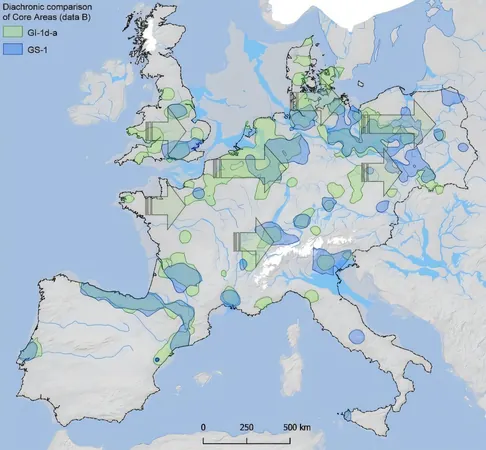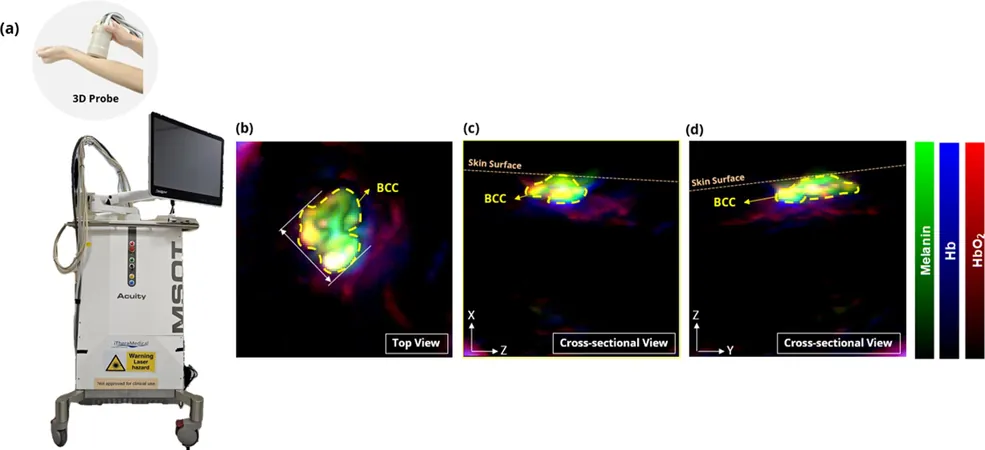
Unveiling the Secrets of Prehistoric Migration: How Climate Change Shaped Human Settlement Patterns 12,000 Years Ago!
2025-04-03
Author: Jia
Introduction
A groundbreaking new study has illuminated how prehistoric hunter-gatherer populations in Europe navigated the tumultuous climate changes that unfolded over 12,000 years ago. Spearheaded by scientists from the University of Cologne and a network of 25 prehistoric archaeologists from twenty esteemed European universities and research institutions, the research has unveiled significant shifts in population size and density during critical periods at the conclusion of the last Ice Age, specifically the Final Paleolithic era between 14,000 and 11,600 years ago.
Significant Findings
This pivotal study is documented in PLOS One with the title, “Large scale and regional demographic responses to climatic changes in Europe during the Final Paleolithic.” The findings reveal that a substantial human population first emerged in northeastern central Europe during the Final Paleolithic, only to face a staggering population decline during the last cold spell of the Ice Age, known as the Greenland Stadial 1. This abrupt climatic shift shrank Europe’s total population by an alarming 50%!.
Interestingly, the research highlights that some areas in central Europe experienced stability or even a mild increase in human population, contrasting the broader decline. Researchers interpret this as evidence of a mass migration eastward as communities sought refuge from increasingly harsh climate conditions.
Research Methodology
Through the meticulous compilation of a broad database detailing archaeological sites from this period, and by employing an innovative geostatistical method dubbed the Cologne Protocol, the researchers were able to estimate population sizes and densities for prehistoric humans across various European regions. This approach not only standardizes demographic estimations but also facilitates diachronic comparisons that enhance our understanding of population dynamics over time.
Pivotal Periods of Study
The study zeros in on two pivotal periods: Greenland Interstadial 1d-a (GI-1d-a) and Greenland Stadial 1 (GS-1). During the GI-1d-a—an unusually warm phase of the Final Paleolithic—humans were seen to repopulate and spread into northern and northeastern central Europe, elevating it to the forefront of demographic activity in prehistory. In stark contrast, southern populations in regions like Spain and France began to dwindle, revealing a significant demographic shift.
When the temperature plummeted in the following GS-1 period, also known as the Younger Dryas, Europe suffered a catastrophic population drop of 50%. Yet, this study emphasizes that regional dynamics were far from uniform: certain areas, including northern Italy, Poland, and northeastern Germany, exhibited an increase in population density, along with a notable movement of populated regions from west to east.
Insights from Experts
“Such shifts likely illustrate how humans adapted through migration towards more hospitable lands in reaction to the severe climatic coolness of the Younger Dryas,” says Dr. Isabell Schmidt from the University of Cologne’s Department of Prehistoric Archaeology. “This suggests a remarkable level of adaptability and foresight among our prehistoric ancestors.”
Historical Context
The Cologne team’s expertise extends to extreme prehistoric population declines, having documented similar patterns during the late Gravettian period (29,000 to 25,000 years ago), a time when cooler temperatures decimated populations in western and central Europe by up to two-thirds, leading to the extinction of several regional communities.
Conclusion
While our understanding of demographic trends from these early chapters of human prehistory is still evolving, this new study contributes crucial insights into the resilience and adaptability of prehistoric humans in the face of climate change, forging a deeper connection between our past and present challenges. Explore the untold stories of our ancestors and how their experiences can inform our responses to today's environmental crises!





 Brasil (PT)
Brasil (PT)
 Canada (EN)
Canada (EN)
 Chile (ES)
Chile (ES)
 Česko (CS)
Česko (CS)
 대한민국 (KO)
대한민국 (KO)
 España (ES)
España (ES)
 France (FR)
France (FR)
 Hong Kong (EN)
Hong Kong (EN)
 Italia (IT)
Italia (IT)
 日本 (JA)
日本 (JA)
 Magyarország (HU)
Magyarország (HU)
 Norge (NO)
Norge (NO)
 Polska (PL)
Polska (PL)
 Schweiz (DE)
Schweiz (DE)
 Singapore (EN)
Singapore (EN)
 Sverige (SV)
Sverige (SV)
 Suomi (FI)
Suomi (FI)
 Türkiye (TR)
Türkiye (TR)
 الإمارات العربية المتحدة (AR)
الإمارات العربية المتحدة (AR)